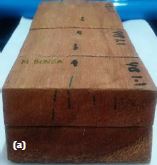High temperature drying properties and basic drying schedule of 5 lesser-known species from Riau

Drying process is a crucial stage in the utilization of any wood for construction and furniture purposes. The study aimed to: (i) investigate the sensitivity of several lesser-known wood species from natural forest in Riau to drying process at high temperature; and (ii) develop basic drying schedule for each wood. Five lesser-known species from Riau were investigated, namely punak (Tetramerista glabra), mempisang (Diospyros korthalsiana), pasak linggo (Aglaia argentea), meranti bunga (Shorea teysmanniana) and suntai (Palaquiumburckii). Modified Terazawa’s (1965) method was used for the experiment. The result shows that deformation was found for all species. The most severe deformation level was observed for both punak (score value of 4-6) and mempisang (score value of 4-5). On the other hand, pasaklinggo experienced the most severe initial end/surface check/split (score value of 6) and honeycombing (score value of 5). The result also showed that punak and pasaklinggo can be dried with the same drying schedule at the temperature range of 40-65° C and the humidity range of 38-88%. The proposed temperature and humidity ranges (or drying schedules) are 50-80° C and 28-80% for suntai, 50-70° C and 25-80% for mempisang, and 50-70° C and 40-84% for meranti bunga. Mempisang and suntai can use the same drying condition until fiber saturation point, then different drying condition applies.
Basri, E. (2011). Kualitas kayu waru gunung (Hibiscus macrophyllusRoxb.) pada 3 kelompok umur dan sifat densifikasinya untuk bahan mebel (Thesis). Yogyakarta: Universitas Gadjah Mada
Basri, E., Hadjib, N., & Saefudin. (2005). Basic properties in relation to drying properties of three wood species from Indonesia. Journal of Forestry Research, 2(1), 49-56. doi: 10.20886/ijfr.2005.2.1.49-56
Basri, E., & Rulliyati, S. (2008). Pengaruh sifat fisik dan anatomi terhadap sifat pengeringan enam jenis kayu. Journal of Forest Product Research, 26(3), 253-262. doi: http://ejournal.forda-mof.org/latihan/index.php/JPHH/article/view/1424
Basri, E., Yuniarti, K., Wahyudi, I., Saefudin, & Damayanti, R. (2015). Effects of girdling on wood properties and drying characteristics of Acacia mangium. Journal of Tropical Forest Science, 27(4), 498-505. doi: http://www.jstor.org/stable/43596226
Boone, R.S., Kozlik, C.J., Bois, P.J., & Wengert, E.M. (1988). Dry kiln schedules for commercial woods : temperate and tropical. Research Report. Wisconsin: Forest Product Laboratory, USDA
Djarwanto, Krisdianto, Supriadi, A., Abdurachman, Jasni, Ismanto, A., Suprapti, S., Yuniarti, K., Anggraeni, D., Pari, G., & Iskandar, M.I. (2016). Sifat dasar dan potensi kegunaan kayu asal Sumatra. Research Report. Bogor: Center for Forest Products Research and Development. (Unpublished)
Effah, B. (2014). The susceptibility of Cola nitidaand Funtumia elasticato some drying defects. International Journal of Science and Technology, 4(2), 37-40. doi: http://ejournalofsciences.org/archive/vol4no2/vol4no2_2.pdf
Hannani, N. (2014). Microwave Drying and Conditioning of Pinus radiata D. Don Sawn Timber (Thesis). Melbourne: University of Melbourne
Keey, R., Langrish, T., & Walker, J. (2000). Kiln-Drying of Lumber(1sted.). Berlin: Springer.
Martawijaya, A., Kartasujana, I., Kadir, K., & Prawira, S.A. (2005). Atlas Kayu Indonesia(3rd ed.). Bogor: Center for Forest Products Research and Development.
Mugabi, P., Rypstra, T., Vermaas, H., & Nel, D. (2010). Relationships between drying defect parameters and some growth characteristics in kiln-dried South African grown Eucalyptus grandis. European Journal of Wood and Wood Products, 68(3), 329-340. doi: 10.1007/s00107-009-0375-4
Mugabi, P., Rypstra, T., Vermaas, H.F., & Nel, D.G. (2011). Effect of kiln drying schedule on the quality of South African grown Eucalyptus grandis poles. European Journal Wood Products,69, 19-26. doi: 10.1007/s00107-009-0392-3
Muslich, M. (2015). RPI 19 Sifat dasar kayu dan bukan kayu. In: Sintesis RPI 2011-2014. Bogor: Center for Forest Products Research and Development.
Oltean, L., Teischinger, A., &Hansmann, C. (2007). Influence of temperature on cracking and mechanical properties of wood during wood drying-a review. BioResources, 2(4), 789-811. doi: http://ojs.cnr.ncsu.edu/index.php/BioRes/article/view/BioRes_2_4_789_811_Oltean_TH_Cracking_Wood_Drying_Review
Phonetip, K., Ozarska, B., & Brodie, G.I. (2017). Comparing two internal check measurement methods for wood drying quality assessment. European Journal of Wood and Wood Products, 75(1), 139-142. doi: 10.1007/s00107-016-1115-1
Suranto, Y., & Prasetyo, E.T. (2012). Penerapan formulasi skedul suhu dan kelembaban menurut Terazawa pada pengeringan kayu Meranti merah bersortimen raamhout.In: Proceedings of the Seminar MAPEKI XV (pp: 171-179). Makassar: Universitas Hasanudin.
Terazawa, S. (1965). An Easy Method for the Determination of Wood Drying Schedule: Wood Industry Japan.
Torgovnikov, G.I., & Vinden, P. (2010). Microwave wood modification technology and its applications. Forest Products Journal, 60(2), 173-182. doi: http://dx.doi.org/10.13073/0015-7473-60.2.173
Vongpradubchai, S., & Rattanadecho, P. (2011). Microwave and hot air drying of wood using a rectangular waveguide. Drying Technology, 29, 451-460. doi: 10.1080/07373937.2010.505312
Yamashita, K., Hirakawa, Y., Saito, S., Nakatani, H., Ikeda, M., & Ohta, M. (2014). Effect of cross-sectional dimensions on bowand surface checking of sugi (Cryptomeria japonica) boxed-heart square timber dried by conventional kiln drying. Journal of Wood Science, 60(1), 1-11. doi: 10.1007/s10086-013-1380-0
Yuniarti, K. (2015). Intermittent Drying of Eucalyptus saligna(Dissertation). Melbourne: The University of Melbourne
Yuniarti, K., & Basri, E. (2016). The sensitivity of Mempisang wood to drying defects under high temperature drying Paper presented at the Seminar MAPEKI XIX, Ambon, Maluku, 20 October
Yuniarti, K., Ozarska, B., Brodie, G., Harris, G., & Waugh, G. (2015). Collapse development on Eucalyptus salignaunder different drying temperature levels. Journal of Tropical Forest Science, 27(4), 462-471. doi: http://www.jstor.org/stable/43596223
Zhang, Y., Jia, K., Cai, L., & Shi, S.Q. (2013). Acceleration of moisture migration in Larch wood through microwave pre-treatments. Drying Technology, 31(6), 666-671. doi: 10.1080/07373937.2012.753610

